Report on the Business Model, Sustainability, and Risks of Pure Ponics
VerifiedAdded on 2021/04/17
|11
|2252
|63
Report
AI Summary
This report provides an in-depth analysis of Pure Ponics, an Australian startup specializing in aquaponics farming. It examines their business model, focusing on their sustainable approach to agriculture, which involves the use of aquaponics for producing organic vegetables and fish. The report utilizes the Business Model Canvas to outline key aspects such as key partners, activities, resources, value proposition, customer relationships, channels, customer segments, cost structure, and revenue streams. Furthermore, it identifies critical success factors, such as market expansion and online presence, and potential downside risks, including market limitations and environmental issues. The report concludes by suggesting changes to the business model, such as enhancing online sales and farmer training, to improve efficiency and competitiveness. The report highlights the importance of sustainability and innovation in gaining a competitive advantage in the agricultural sector.

Running head: THINK BIG
Think big
Name of the student
Name of the student
Author note
Think big
Name of the student
Name of the student
Author note
Paraphrase This Document
Need a fresh take? Get an instant paraphrase of this document with our AI Paraphraser
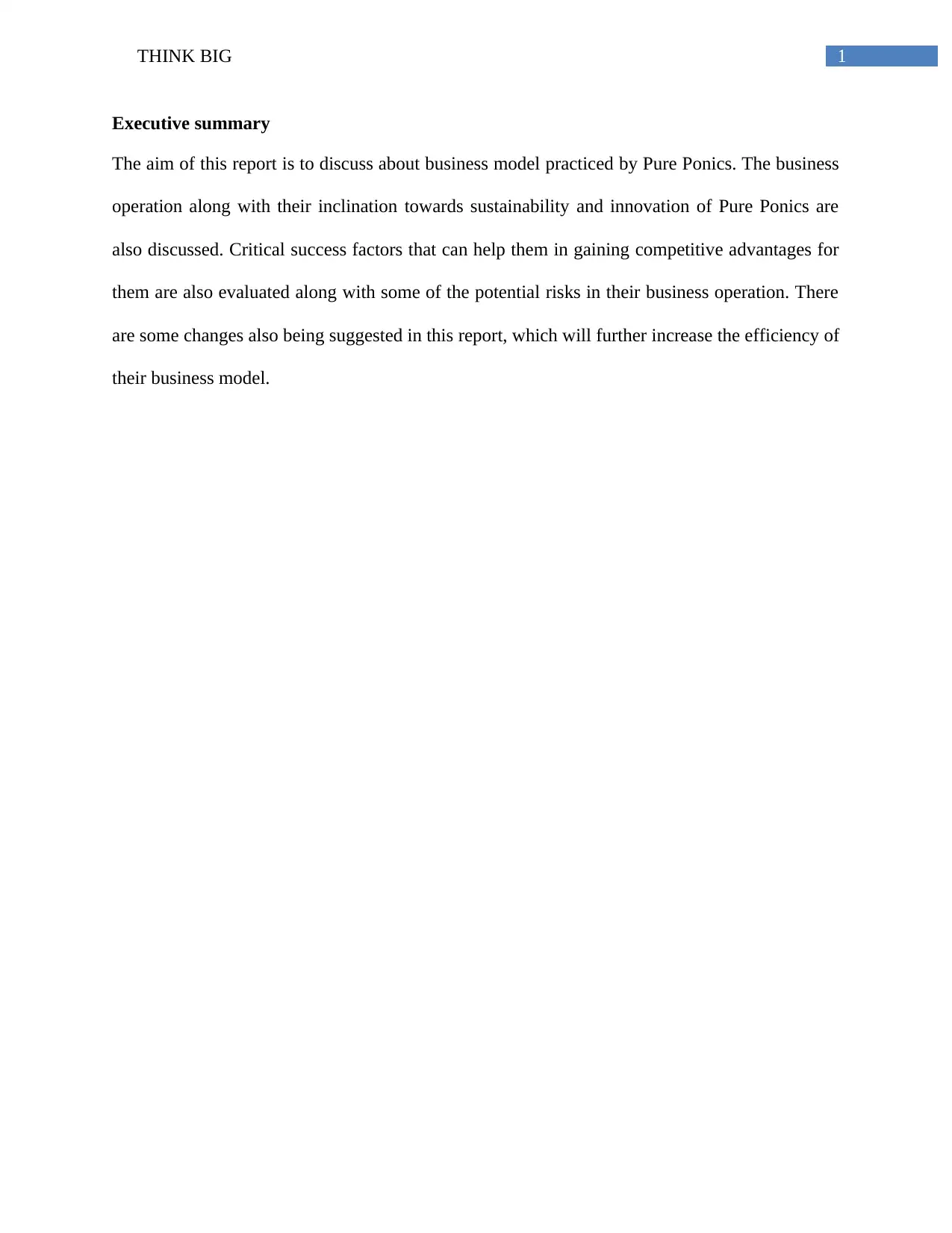
1THINK BIG
Executive summary
The aim of this report is to discuss about business model practiced by Pure Ponics. The business
operation along with their inclination towards sustainability and innovation of Pure Ponics are
also discussed. Critical success factors that can help them in gaining competitive advantages for
them are also evaluated along with some of the potential risks in their business operation. There
are some changes also being suggested in this report, which will further increase the efficiency of
their business model.
Executive summary
The aim of this report is to discuss about business model practiced by Pure Ponics. The business
operation along with their inclination towards sustainability and innovation of Pure Ponics are
also discussed. Critical success factors that can help them in gaining competitive advantages for
them are also evaluated along with some of the potential risks in their business operation. There
are some changes also being suggested in this report, which will further increase the efficiency of
their business model.
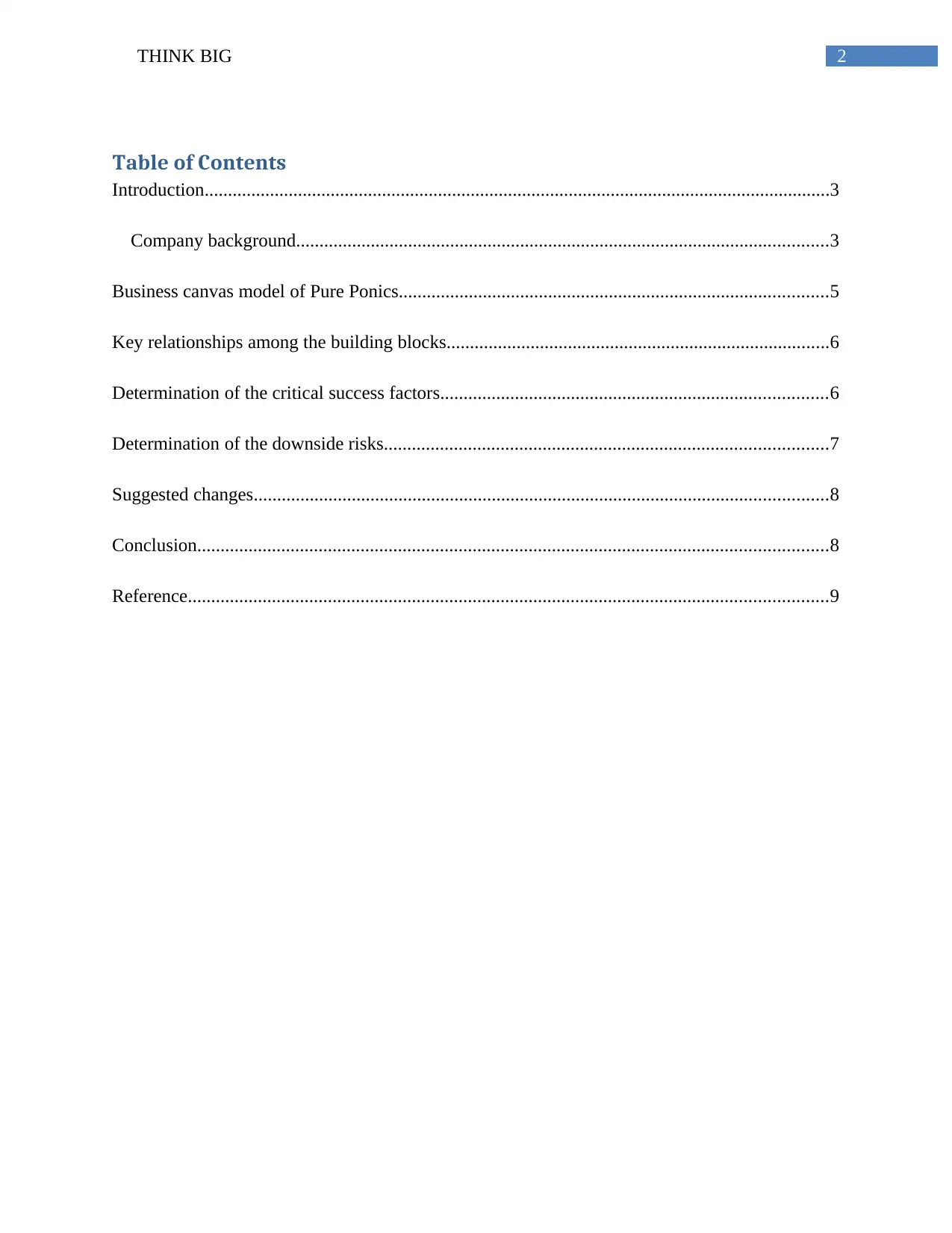
2THINK BIG
Table of Contents
Introduction......................................................................................................................................3
Company background..................................................................................................................3
Business canvas model of Pure Ponics............................................................................................5
Key relationships among the building blocks..................................................................................6
Determination of the critical success factors...................................................................................6
Determination of the downside risks...............................................................................................7
Suggested changes...........................................................................................................................8
Conclusion.......................................................................................................................................8
Reference.........................................................................................................................................9
Table of Contents
Introduction......................................................................................................................................3
Company background..................................................................................................................3
Business canvas model of Pure Ponics............................................................................................5
Key relationships among the building blocks..................................................................................6
Determination of the critical success factors...................................................................................6
Determination of the downside risks...............................................................................................7
Suggested changes...........................................................................................................................8
Conclusion.......................................................................................................................................8
Reference.........................................................................................................................................9
⊘ This is a preview!⊘
Do you want full access?
Subscribe today to unlock all pages.

Trusted by 1+ million students worldwide
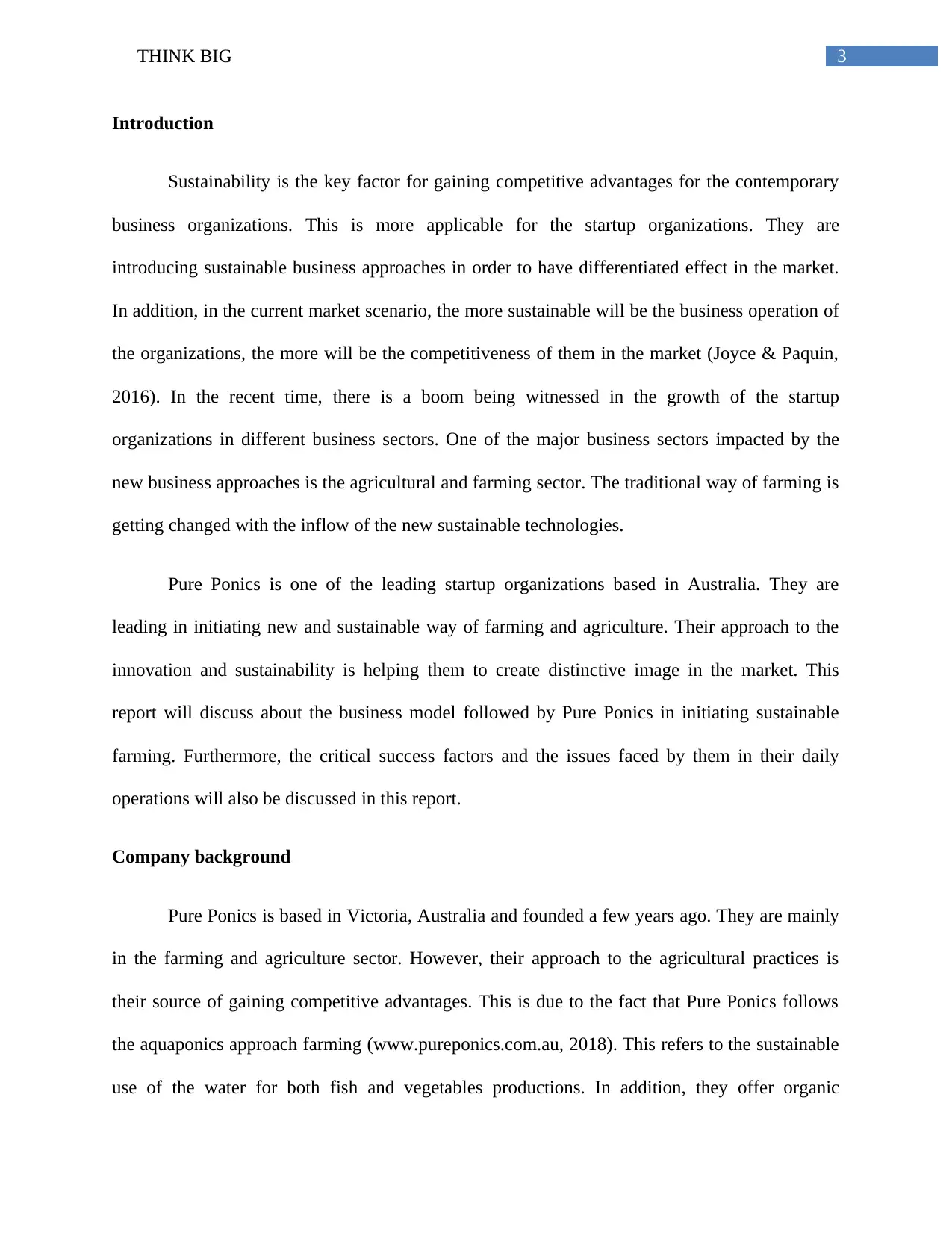
3THINK BIG
Introduction
Sustainability is the key factor for gaining competitive advantages for the contemporary
business organizations. This is more applicable for the startup organizations. They are
introducing sustainable business approaches in order to have differentiated effect in the market.
In addition, in the current market scenario, the more sustainable will be the business operation of
the organizations, the more will be the competitiveness of them in the market (Joyce & Paquin,
2016). In the recent time, there is a boom being witnessed in the growth of the startup
organizations in different business sectors. One of the major business sectors impacted by the
new business approaches is the agricultural and farming sector. The traditional way of farming is
getting changed with the inflow of the new sustainable technologies.
Pure Ponics is one of the leading startup organizations based in Australia. They are
leading in initiating new and sustainable way of farming and agriculture. Their approach to the
innovation and sustainability is helping them to create distinctive image in the market. This
report will discuss about the business model followed by Pure Ponics in initiating sustainable
farming. Furthermore, the critical success factors and the issues faced by them in their daily
operations will also be discussed in this report.
Company background
Pure Ponics is based in Victoria, Australia and founded a few years ago. They are mainly
in the farming and agriculture sector. However, their approach to the agricultural practices is
their source of gaining competitive advantages. This is due to the fact that Pure Ponics follows
the aquaponics approach farming (www.pureponics.com.au, 2018). This refers to the sustainable
use of the water for both fish and vegetables productions. In addition, they offer organic
Introduction
Sustainability is the key factor for gaining competitive advantages for the contemporary
business organizations. This is more applicable for the startup organizations. They are
introducing sustainable business approaches in order to have differentiated effect in the market.
In addition, in the current market scenario, the more sustainable will be the business operation of
the organizations, the more will be the competitiveness of them in the market (Joyce & Paquin,
2016). In the recent time, there is a boom being witnessed in the growth of the startup
organizations in different business sectors. One of the major business sectors impacted by the
new business approaches is the agricultural and farming sector. The traditional way of farming is
getting changed with the inflow of the new sustainable technologies.
Pure Ponics is one of the leading startup organizations based in Australia. They are
leading in initiating new and sustainable way of farming and agriculture. Their approach to the
innovation and sustainability is helping them to create distinctive image in the market. This
report will discuss about the business model followed by Pure Ponics in initiating sustainable
farming. Furthermore, the critical success factors and the issues faced by them in their daily
operations will also be discussed in this report.
Company background
Pure Ponics is based in Victoria, Australia and founded a few years ago. They are mainly
in the farming and agriculture sector. However, their approach to the agricultural practices is
their source of gaining competitive advantages. This is due to the fact that Pure Ponics follows
the aquaponics approach farming (www.pureponics.com.au, 2018). This refers to the sustainable
use of the water for both fish and vegetables productions. In addition, they offer organic
Paraphrase This Document
Need a fresh take? Get an instant paraphrase of this document with our AI Paraphraser
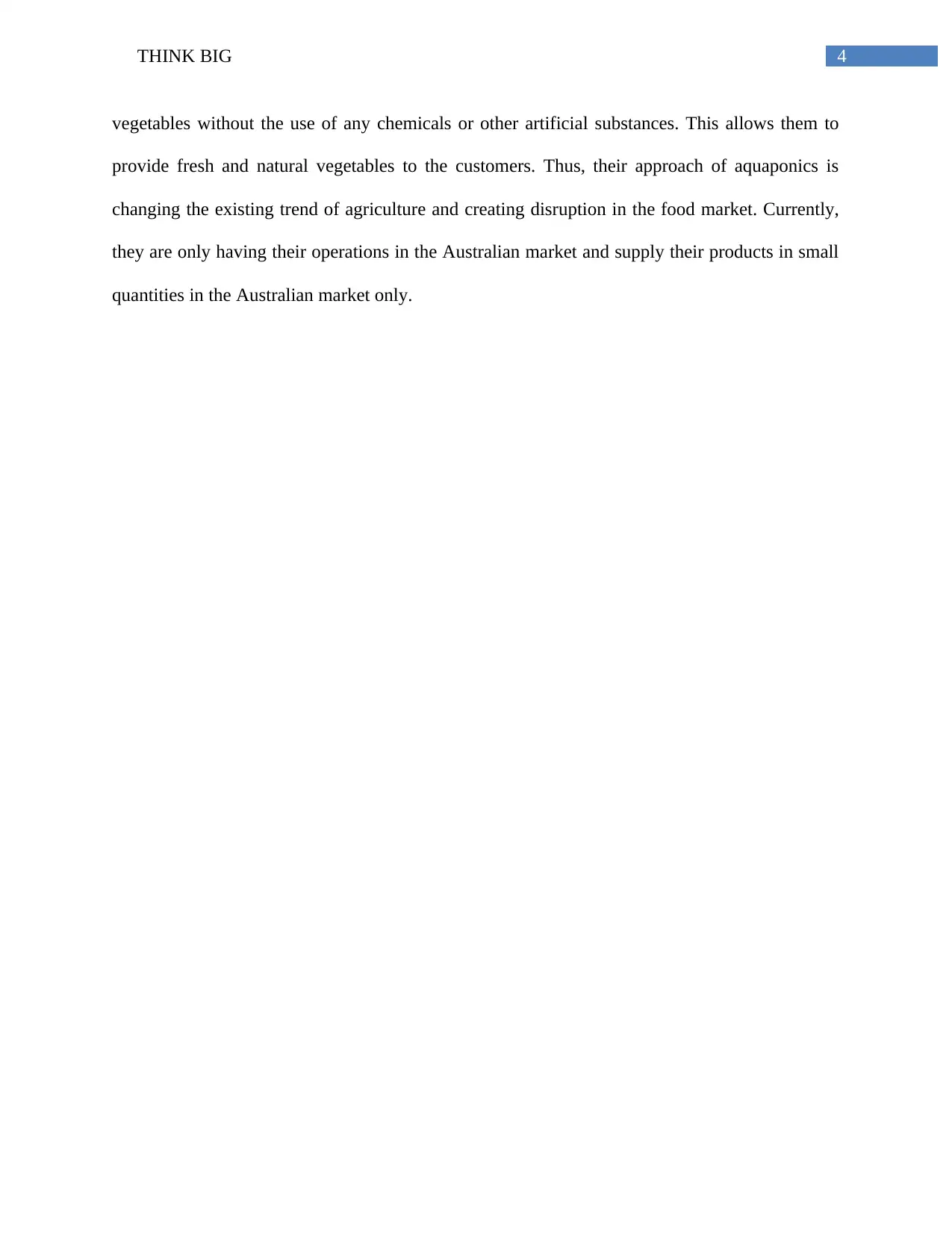
4THINK BIG
vegetables without the use of any chemicals or other artificial substances. This allows them to
provide fresh and natural vegetables to the customers. Thus, their approach of aquaponics is
changing the existing trend of agriculture and creating disruption in the food market. Currently,
they are only having their operations in the Australian market and supply their products in small
quantities in the Australian market only.
vegetables without the use of any chemicals or other artificial substances. This allows them to
provide fresh and natural vegetables to the customers. Thus, their approach of aquaponics is
changing the existing trend of agriculture and creating disruption in the food market. Currently,
they are only having their operations in the Australian market and supply their products in small
quantities in the Australian market only.
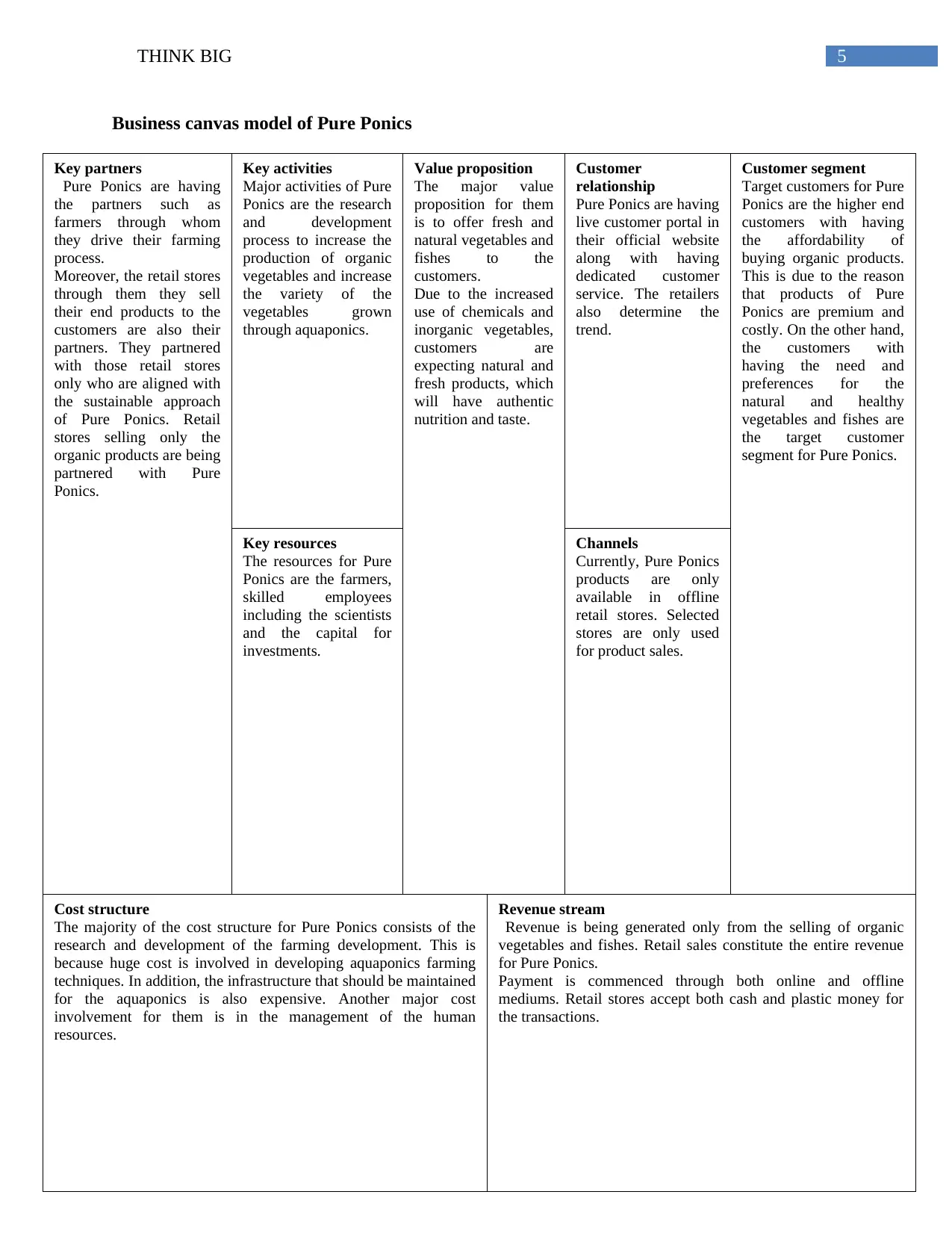
5THINK BIG
Key partners
Pure Ponics are having
the partners such as
farmers through whom
they drive their farming
process.
Moreover, the retail stores
through them they sell
their end products to the
customers are also their
partners. They partnered
with those retail stores
only who are aligned with
the sustainable approach
of Pure Ponics. Retail
stores selling only the
organic products are being
partnered with Pure
Ponics.
Key activities
Major activities of Pure
Ponics are the research
and development
process to increase the
production of organic
vegetables and increase
the variety of the
vegetables grown
through aquaponics.
Key resources
The resources for Pure
Ponics are the farmers,
skilled employees
including the scientists
and the capital for
investments.
Value proposition
The major value
proposition for them
is to offer fresh and
natural vegetables and
fishes to the
customers.
Due to the increased
use of chemicals and
inorganic vegetables,
customers are
expecting natural and
fresh products, which
will have authentic
nutrition and taste.
Customer
relationship
Pure Ponics are having
live customer portal in
their official website
along with having
dedicated customer
service. The retailers
also determine the
trend.
Channels
Currently, Pure Ponics
products are only
available in offline
retail stores. Selected
stores are only used
for product sales.
Customer segment
Target customers for Pure
Ponics are the higher end
customers with having
the affordability of
buying organic products.
This is due to the reason
that products of Pure
Ponics are premium and
costly. On the other hand,
the customers with
having the need and
preferences for the
natural and healthy
vegetables and fishes are
the target customer
segment for Pure Ponics.
Cost structure
The majority of the cost structure for Pure Ponics consists of the
research and development of the farming development. This is
because huge cost is involved in developing aquaponics farming
techniques. In addition, the infrastructure that should be maintained
for the aquaponics is also expensive. Another major cost
involvement for them is in the management of the human
resources.
Revenue stream
Revenue is being generated only from the selling of organic
vegetables and fishes. Retail sales constitute the entire revenue
for Pure Ponics.
Payment is commenced through both online and offline
mediums. Retail stores accept both cash and plastic money for
the transactions.
Business canvas model of Pure Ponics
Key partners
Pure Ponics are having
the partners such as
farmers through whom
they drive their farming
process.
Moreover, the retail stores
through them they sell
their end products to the
customers are also their
partners. They partnered
with those retail stores
only who are aligned with
the sustainable approach
of Pure Ponics. Retail
stores selling only the
organic products are being
partnered with Pure
Ponics.
Key activities
Major activities of Pure
Ponics are the research
and development
process to increase the
production of organic
vegetables and increase
the variety of the
vegetables grown
through aquaponics.
Key resources
The resources for Pure
Ponics are the farmers,
skilled employees
including the scientists
and the capital for
investments.
Value proposition
The major value
proposition for them
is to offer fresh and
natural vegetables and
fishes to the
customers.
Due to the increased
use of chemicals and
inorganic vegetables,
customers are
expecting natural and
fresh products, which
will have authentic
nutrition and taste.
Customer
relationship
Pure Ponics are having
live customer portal in
their official website
along with having
dedicated customer
service. The retailers
also determine the
trend.
Channels
Currently, Pure Ponics
products are only
available in offline
retail stores. Selected
stores are only used
for product sales.
Customer segment
Target customers for Pure
Ponics are the higher end
customers with having
the affordability of
buying organic products.
This is due to the reason
that products of Pure
Ponics are premium and
costly. On the other hand,
the customers with
having the need and
preferences for the
natural and healthy
vegetables and fishes are
the target customer
segment for Pure Ponics.
Cost structure
The majority of the cost structure for Pure Ponics consists of the
research and development of the farming development. This is
because huge cost is involved in developing aquaponics farming
techniques. In addition, the infrastructure that should be maintained
for the aquaponics is also expensive. Another major cost
involvement for them is in the management of the human
resources.
Revenue stream
Revenue is being generated only from the selling of organic
vegetables and fishes. Retail sales constitute the entire revenue
for Pure Ponics.
Payment is commenced through both online and offline
mediums. Retail stores accept both cash and plastic money for
the transactions.
Business canvas model of Pure Ponics
⊘ This is a preview!⊘
Do you want full access?
Subscribe today to unlock all pages.

Trusted by 1+ million students worldwide
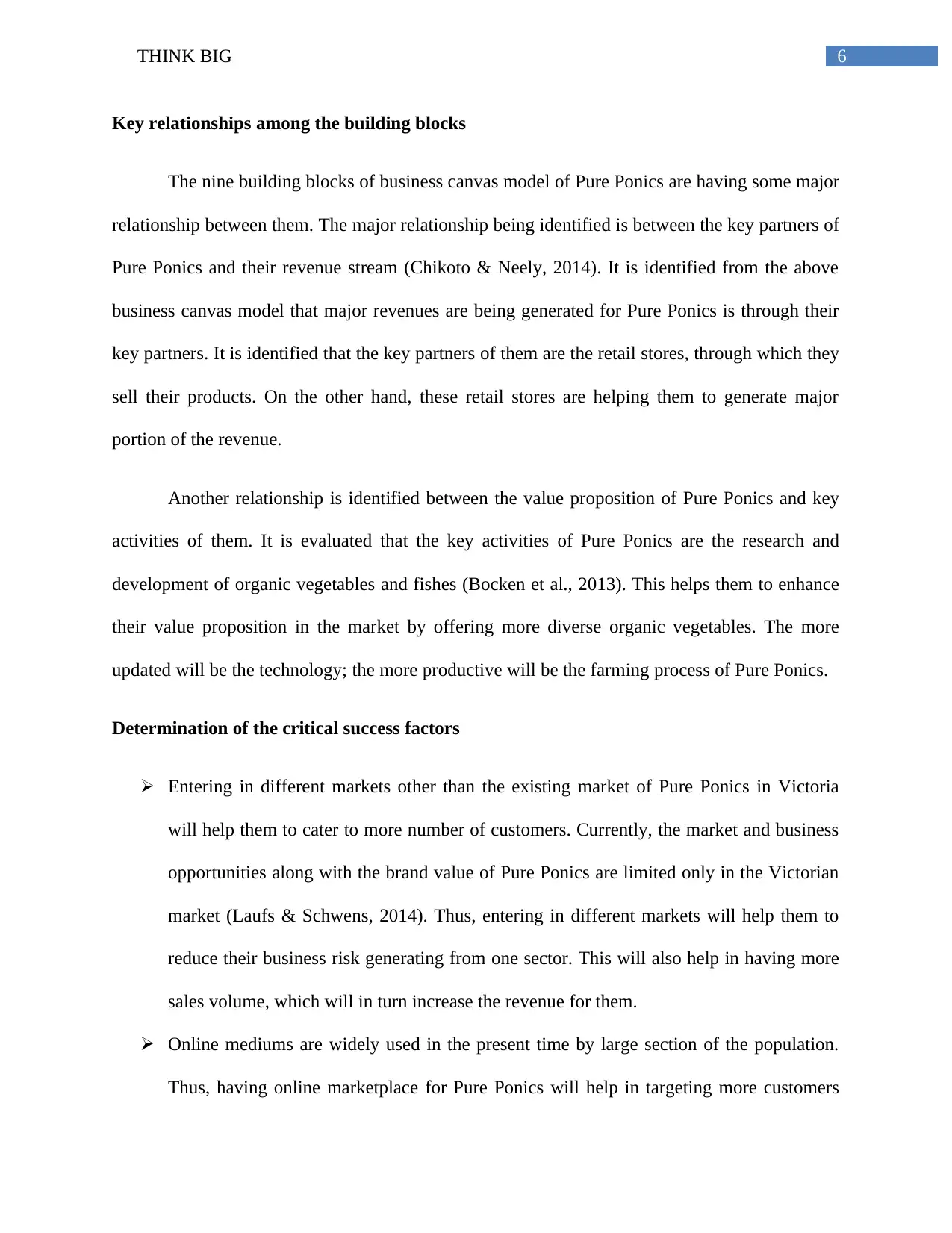
6THINK BIG
Key relationships among the building blocks
The nine building blocks of business canvas model of Pure Ponics are having some major
relationship between them. The major relationship being identified is between the key partners of
Pure Ponics and their revenue stream (Chikoto & Neely, 2014). It is identified from the above
business canvas model that major revenues are being generated for Pure Ponics is through their
key partners. It is identified that the key partners of them are the retail stores, through which they
sell their products. On the other hand, these retail stores are helping them to generate major
portion of the revenue.
Another relationship is identified between the value proposition of Pure Ponics and key
activities of them. It is evaluated that the key activities of Pure Ponics are the research and
development of organic vegetables and fishes (Bocken et al., 2013). This helps them to enhance
their value proposition in the market by offering more diverse organic vegetables. The more
updated will be the technology; the more productive will be the farming process of Pure Ponics.
Determination of the critical success factors
Entering in different markets other than the existing market of Pure Ponics in Victoria
will help them to cater to more number of customers. Currently, the market and business
opportunities along with the brand value of Pure Ponics are limited only in the Victorian
market (Laufs & Schwens, 2014). Thus, entering in different markets will help them to
reduce their business risk generating from one sector. This will also help in having more
sales volume, which will in turn increase the revenue for them.
Online mediums are widely used in the present time by large section of the population.
Thus, having online marketplace for Pure Ponics will help in targeting more customers
Key relationships among the building blocks
The nine building blocks of business canvas model of Pure Ponics are having some major
relationship between them. The major relationship being identified is between the key partners of
Pure Ponics and their revenue stream (Chikoto & Neely, 2014). It is identified from the above
business canvas model that major revenues are being generated for Pure Ponics is through their
key partners. It is identified that the key partners of them are the retail stores, through which they
sell their products. On the other hand, these retail stores are helping them to generate major
portion of the revenue.
Another relationship is identified between the value proposition of Pure Ponics and key
activities of them. It is evaluated that the key activities of Pure Ponics are the research and
development of organic vegetables and fishes (Bocken et al., 2013). This helps them to enhance
their value proposition in the market by offering more diverse organic vegetables. The more
updated will be the technology; the more productive will be the farming process of Pure Ponics.
Determination of the critical success factors
Entering in different markets other than the existing market of Pure Ponics in Victoria
will help them to cater to more number of customers. Currently, the market and business
opportunities along with the brand value of Pure Ponics are limited only in the Victorian
market (Laufs & Schwens, 2014). Thus, entering in different markets will help them to
reduce their business risk generating from one sector. This will also help in having more
sales volume, which will in turn increase the revenue for them.
Online mediums are widely used in the present time by large section of the population.
Thus, having online marketplace for Pure Ponics will help in targeting more customers
Paraphrase This Document
Need a fresh take? Get an instant paraphrase of this document with our AI Paraphraser
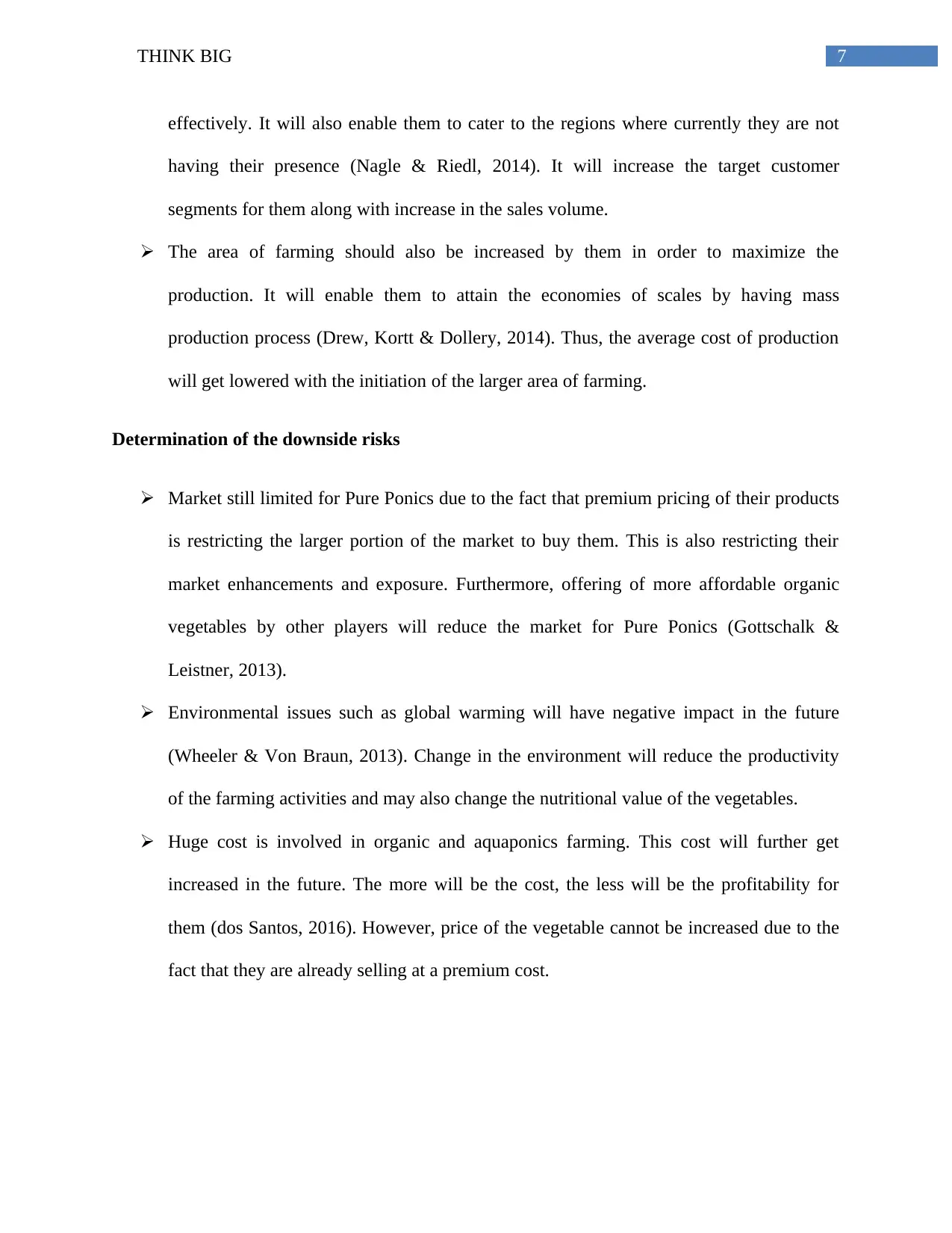
7THINK BIG
effectively. It will also enable them to cater to the regions where currently they are not
having their presence (Nagle & Riedl, 2014). It will increase the target customer
segments for them along with increase in the sales volume.
The area of farming should also be increased by them in order to maximize the
production. It will enable them to attain the economies of scales by having mass
production process (Drew, Kortt & Dollery, 2014). Thus, the average cost of production
will get lowered with the initiation of the larger area of farming.
Determination of the downside risks
Market still limited for Pure Ponics due to the fact that premium pricing of their products
is restricting the larger portion of the market to buy them. This is also restricting their
market enhancements and exposure. Furthermore, offering of more affordable organic
vegetables by other players will reduce the market for Pure Ponics (Gottschalk &
Leistner, 2013).
Environmental issues such as global warming will have negative impact in the future
(Wheeler & Von Braun, 2013). Change in the environment will reduce the productivity
of the farming activities and may also change the nutritional value of the vegetables.
Huge cost is involved in organic and aquaponics farming. This cost will further get
increased in the future. The more will be the cost, the less will be the profitability for
them (dos Santos, 2016). However, price of the vegetable cannot be increased due to the
fact that they are already selling at a premium cost.
effectively. It will also enable them to cater to the regions where currently they are not
having their presence (Nagle & Riedl, 2014). It will increase the target customer
segments for them along with increase in the sales volume.
The area of farming should also be increased by them in order to maximize the
production. It will enable them to attain the economies of scales by having mass
production process (Drew, Kortt & Dollery, 2014). Thus, the average cost of production
will get lowered with the initiation of the larger area of farming.
Determination of the downside risks
Market still limited for Pure Ponics due to the fact that premium pricing of their products
is restricting the larger portion of the market to buy them. This is also restricting their
market enhancements and exposure. Furthermore, offering of more affordable organic
vegetables by other players will reduce the market for Pure Ponics (Gottschalk &
Leistner, 2013).
Environmental issues such as global warming will have negative impact in the future
(Wheeler & Von Braun, 2013). Change in the environment will reduce the productivity
of the farming activities and may also change the nutritional value of the vegetables.
Huge cost is involved in organic and aquaponics farming. This cost will further get
increased in the future. The more will be the cost, the less will be the profitability for
them (dos Santos, 2016). However, price of the vegetable cannot be increased due to the
fact that they are already selling at a premium cost.
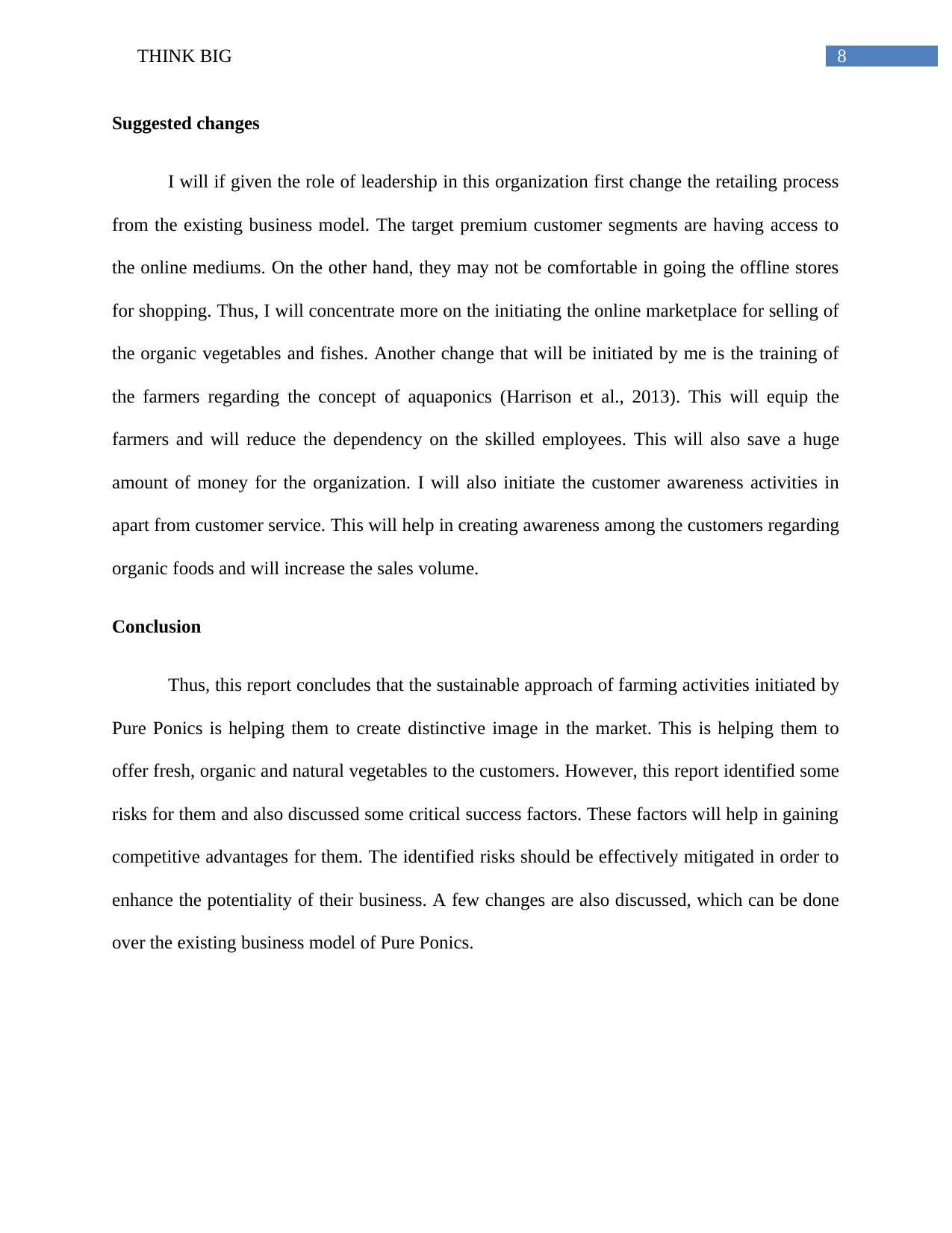
8THINK BIG
Suggested changes
I will if given the role of leadership in this organization first change the retailing process
from the existing business model. The target premium customer segments are having access to
the online mediums. On the other hand, they may not be comfortable in going the offline stores
for shopping. Thus, I will concentrate more on the initiating the online marketplace for selling of
the organic vegetables and fishes. Another change that will be initiated by me is the training of
the farmers regarding the concept of aquaponics (Harrison et al., 2013). This will equip the
farmers and will reduce the dependency on the skilled employees. This will also save a huge
amount of money for the organization. I will also initiate the customer awareness activities in
apart from customer service. This will help in creating awareness among the customers regarding
organic foods and will increase the sales volume.
Conclusion
Thus, this report concludes that the sustainable approach of farming activities initiated by
Pure Ponics is helping them to create distinctive image in the market. This is helping them to
offer fresh, organic and natural vegetables to the customers. However, this report identified some
risks for them and also discussed some critical success factors. These factors will help in gaining
competitive advantages for them. The identified risks should be effectively mitigated in order to
enhance the potentiality of their business. A few changes are also discussed, which can be done
over the existing business model of Pure Ponics.
Suggested changes
I will if given the role of leadership in this organization first change the retailing process
from the existing business model. The target premium customer segments are having access to
the online mediums. On the other hand, they may not be comfortable in going the offline stores
for shopping. Thus, I will concentrate more on the initiating the online marketplace for selling of
the organic vegetables and fishes. Another change that will be initiated by me is the training of
the farmers regarding the concept of aquaponics (Harrison et al., 2013). This will equip the
farmers and will reduce the dependency on the skilled employees. This will also save a huge
amount of money for the organization. I will also initiate the customer awareness activities in
apart from customer service. This will help in creating awareness among the customers regarding
organic foods and will increase the sales volume.
Conclusion
Thus, this report concludes that the sustainable approach of farming activities initiated by
Pure Ponics is helping them to create distinctive image in the market. This is helping them to
offer fresh, organic and natural vegetables to the customers. However, this report identified some
risks for them and also discussed some critical success factors. These factors will help in gaining
competitive advantages for them. The identified risks should be effectively mitigated in order to
enhance the potentiality of their business. A few changes are also discussed, which can be done
over the existing business model of Pure Ponics.
⊘ This is a preview!⊘
Do you want full access?
Subscribe today to unlock all pages.

Trusted by 1+ million students worldwide
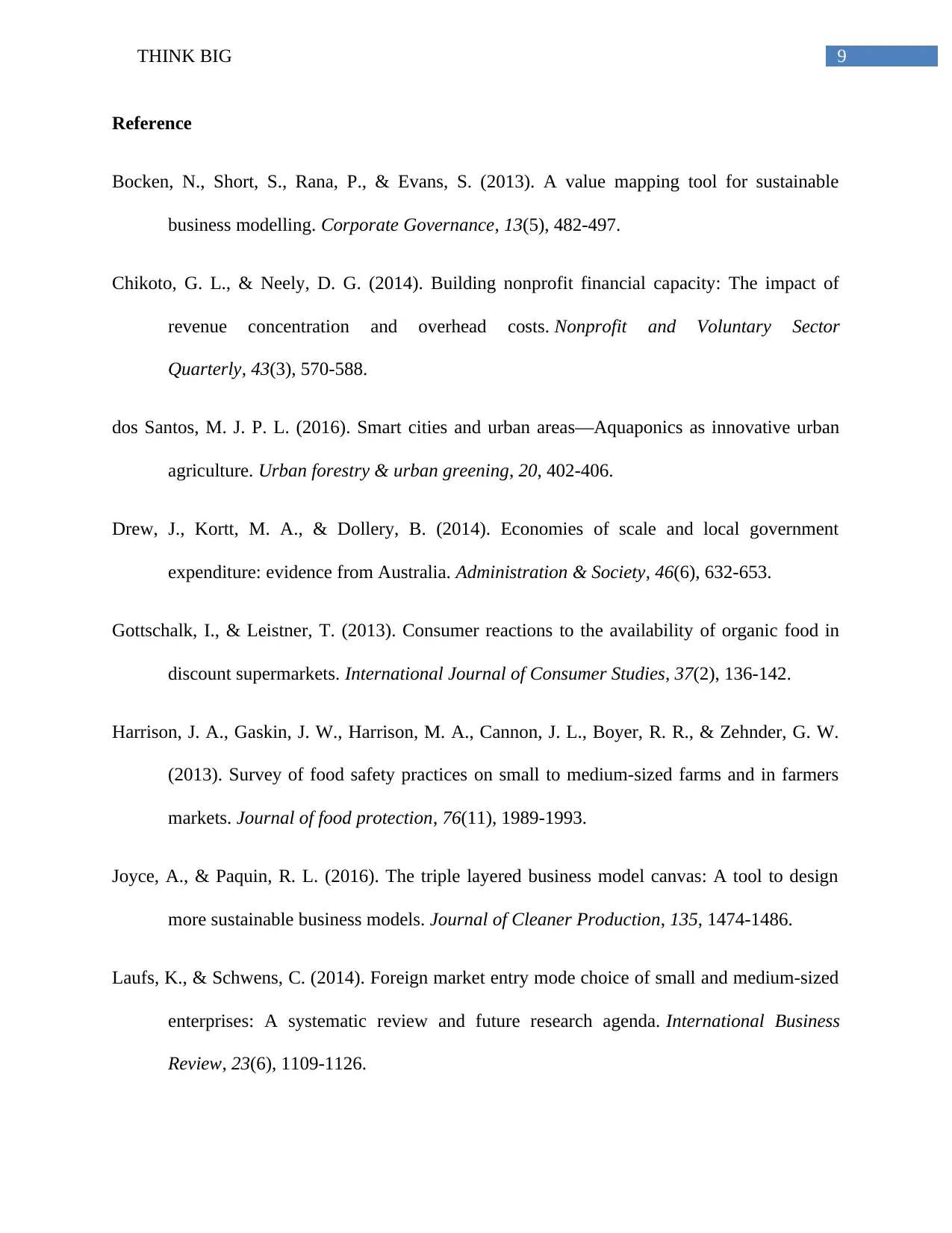
9THINK BIG
Reference
Bocken, N., Short, S., Rana, P., & Evans, S. (2013). A value mapping tool for sustainable
business modelling. Corporate Governance, 13(5), 482-497.
Chikoto, G. L., & Neely, D. G. (2014). Building nonprofit financial capacity: The impact of
revenue concentration and overhead costs. Nonprofit and Voluntary Sector
Quarterly, 43(3), 570-588.
dos Santos, M. J. P. L. (2016). Smart cities and urban areas—Aquaponics as innovative urban
agriculture. Urban forestry & urban greening, 20, 402-406.
Drew, J., Kortt, M. A., & Dollery, B. (2014). Economies of scale and local government
expenditure: evidence from Australia. Administration & Society, 46(6), 632-653.
Gottschalk, I., & Leistner, T. (2013). Consumer reactions to the availability of organic food in
discount supermarkets. International Journal of Consumer Studies, 37(2), 136-142.
Harrison, J. A., Gaskin, J. W., Harrison, M. A., Cannon, J. L., Boyer, R. R., & Zehnder, G. W.
(2013). Survey of food safety practices on small to medium-sized farms and in farmers
markets. Journal of food protection, 76(11), 1989-1993.
Joyce, A., & Paquin, R. L. (2016). The triple layered business model canvas: A tool to design
more sustainable business models. Journal of Cleaner Production, 135, 1474-1486.
Laufs, K., & Schwens, C. (2014). Foreign market entry mode choice of small and medium-sized
enterprises: A systematic review and future research agenda. International Business
Review, 23(6), 1109-1126.
Reference
Bocken, N., Short, S., Rana, P., & Evans, S. (2013). A value mapping tool for sustainable
business modelling. Corporate Governance, 13(5), 482-497.
Chikoto, G. L., & Neely, D. G. (2014). Building nonprofit financial capacity: The impact of
revenue concentration and overhead costs. Nonprofit and Voluntary Sector
Quarterly, 43(3), 570-588.
dos Santos, M. J. P. L. (2016). Smart cities and urban areas—Aquaponics as innovative urban
agriculture. Urban forestry & urban greening, 20, 402-406.
Drew, J., Kortt, M. A., & Dollery, B. (2014). Economies of scale and local government
expenditure: evidence from Australia. Administration & Society, 46(6), 632-653.
Gottschalk, I., & Leistner, T. (2013). Consumer reactions to the availability of organic food in
discount supermarkets. International Journal of Consumer Studies, 37(2), 136-142.
Harrison, J. A., Gaskin, J. W., Harrison, M. A., Cannon, J. L., Boyer, R. R., & Zehnder, G. W.
(2013). Survey of food safety practices on small to medium-sized farms and in farmers
markets. Journal of food protection, 76(11), 1989-1993.
Joyce, A., & Paquin, R. L. (2016). The triple layered business model canvas: A tool to design
more sustainable business models. Journal of Cleaner Production, 135, 1474-1486.
Laufs, K., & Schwens, C. (2014). Foreign market entry mode choice of small and medium-sized
enterprises: A systematic review and future research agenda. International Business
Review, 23(6), 1109-1126.
Paraphrase This Document
Need a fresh take? Get an instant paraphrase of this document with our AI Paraphraser
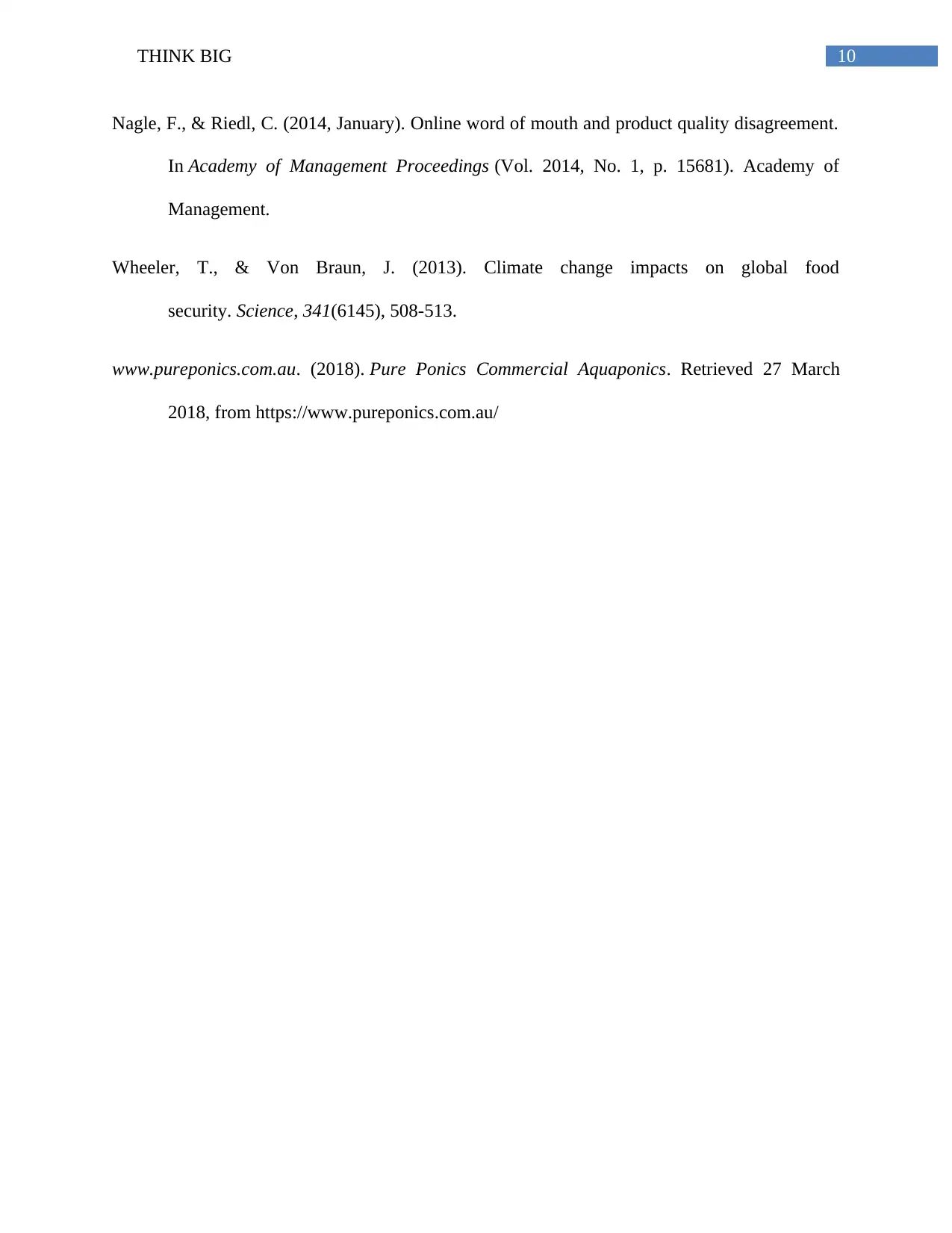
10THINK BIG
Nagle, F., & Riedl, C. (2014, January). Online word of mouth and product quality disagreement.
In Academy of Management Proceedings (Vol. 2014, No. 1, p. 15681). Academy of
Management.
Wheeler, T., & Von Braun, J. (2013). Climate change impacts on global food
security. Science, 341(6145), 508-513.
www.pureponics.com.au. (2018). Pure Ponics Commercial Aquaponics. Retrieved 27 March
2018, from https://www.pureponics.com.au/
Nagle, F., & Riedl, C. (2014, January). Online word of mouth and product quality disagreement.
In Academy of Management Proceedings (Vol. 2014, No. 1, p. 15681). Academy of
Management.
Wheeler, T., & Von Braun, J. (2013). Climate change impacts on global food
security. Science, 341(6145), 508-513.
www.pureponics.com.au. (2018). Pure Ponics Commercial Aquaponics. Retrieved 27 March
2018, from https://www.pureponics.com.au/
1 out of 11
Related Documents
Your All-in-One AI-Powered Toolkit for Academic Success.
+13062052269
info@desklib.com
Available 24*7 on WhatsApp / Email
![[object Object]](/_next/static/media/star-bottom.7253800d.svg)
Unlock your academic potential
Copyright © 2020–2025 A2Z Services. All Rights Reserved. Developed and managed by ZUCOL.



